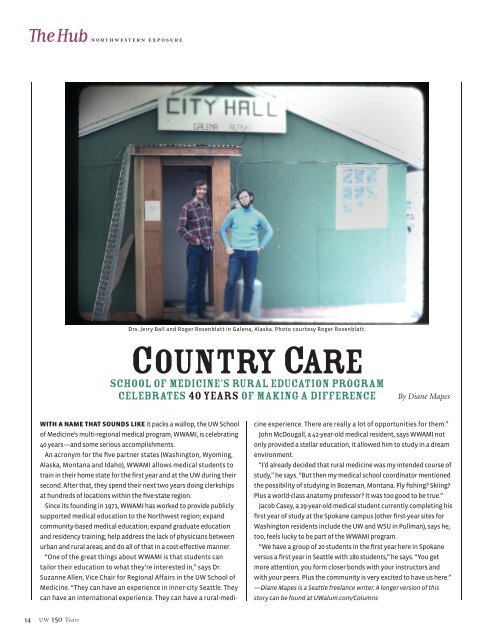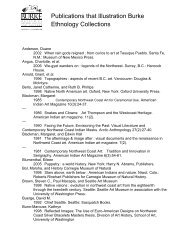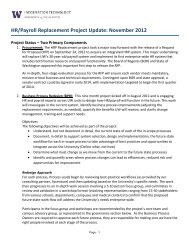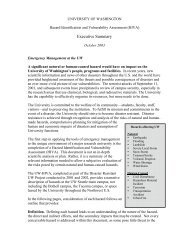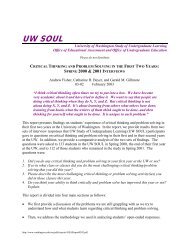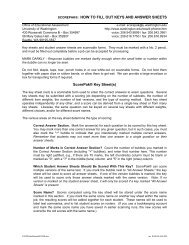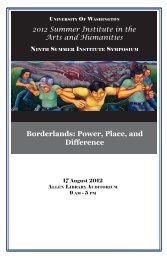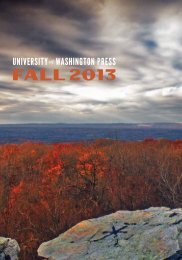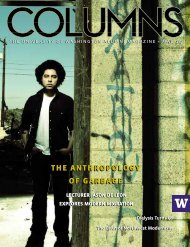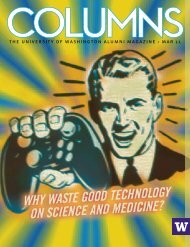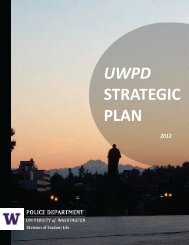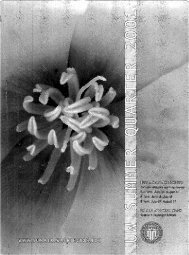PDF version - University of Washington
PDF version - University of Washington
PDF version - University of Washington
You also want an ePaper? Increase the reach of your titles
YUMPU automatically turns print PDFs into web optimized ePapers that Google loves.
The Hub northwestern exposure<br />
Drs. Jerry Ball and Roger Rosenblatt in Galena, Alaska. Photo courtesy Roger Rosenblatt.<br />
Country Care<br />
School <strong>of</strong> Medicine’s rural education program<br />
celebrates 40 years <strong>of</strong> making a difference<br />
By Diane Mapes<br />
WITH A NAME THAT SOUNDS LIKE it packs a wallop, the UW School<br />
<strong>of</strong> Medicine’s multi-regional medical program, WWAMI, is celebrating<br />
40 years—and some serious accomplishments.<br />
An acronym for the five partner states (<strong>Washington</strong>, Wyoming,<br />
Alaska, Montana and Idaho), WWAMI allows medical students to<br />
train in their home state for the first year and at the UW during their<br />
second. After that, they spend their next two years doing clerkships<br />
at hundreds <strong>of</strong> locations within the five-state region.<br />
Since its founding in 1971, WWAMI has worked to provide publicly<br />
supported medical education to the Northwest region; expand<br />
community-based medical education; expand graduate education<br />
and residency training; help address the lack <strong>of</strong> physicians between<br />
urban and rural areas; and do all <strong>of</strong> that in a cost-effective manner.<br />
“One <strong>of</strong> the great things about WWAMI is that students can<br />
tailor their education to what they’re interested in,” says Dr.<br />
Suzanne Allen, Vice Chair for Regional Affairs in the UW School <strong>of</strong><br />
Medicine. “They can have an experience in inner-city Seattle. They<br />
can have an international experience. They can have a rural-medicine<br />
experience. There are really a lot <strong>of</strong> opportunities for them.”<br />
John McDougall, a 42-year-old medical resident, says WWAMI not<br />
only provided a stellar education, it allowed him to study in a dream<br />
environment.<br />
“I’d already decided that rural medicine was my intended course <strong>of</strong><br />
study,” he says. “But then my medical school coordinator mentioned<br />
the possibility <strong>of</strong> studying in Bozeman, Montana. Fly fishing? Skiing?<br />
Plus a world-class anatomy pr<strong>of</strong>essor? It was too good to be true.”<br />
Jacob Casey, a 29-year-old medical student currently completing his<br />
first year <strong>of</strong> study at the Spokane campus (other first-year sites for<br />
<strong>Washington</strong> residents include the UW and WSU in Pullman), says he,<br />
too, feels lucky to be part <strong>of</strong> the WWAMI program.<br />
“We have a group <strong>of</strong> 20 students in the first year here in Spokane<br />
versus a first year in Seattle with 180 students,” he says. “You get<br />
more attention, you form closer bonds with your instructors and<br />
with your peers. Plus the community is very excited to have us here.”<br />
—Diane Mapes is a Seattle freelance writer. A longer <strong>version</strong> <strong>of</strong> this<br />
story can be found at UWalum.com/Columns<br />
14 UW 150 Years


